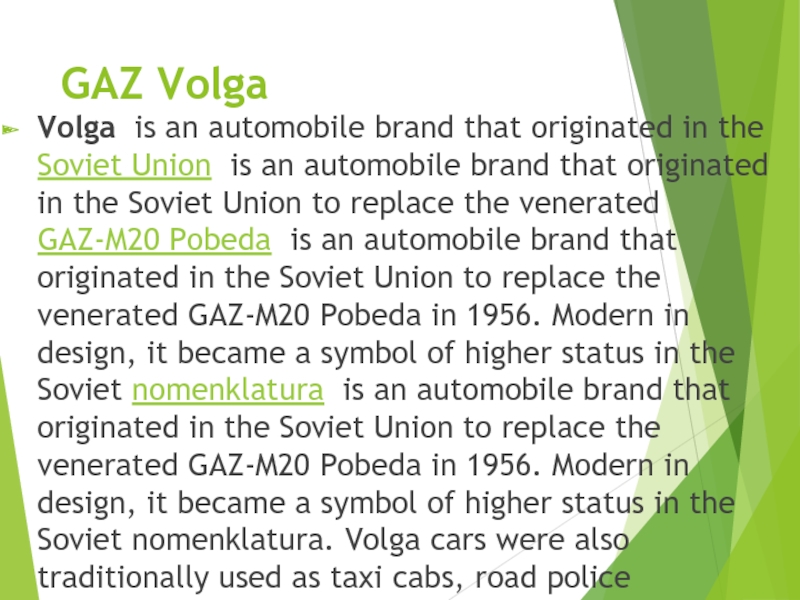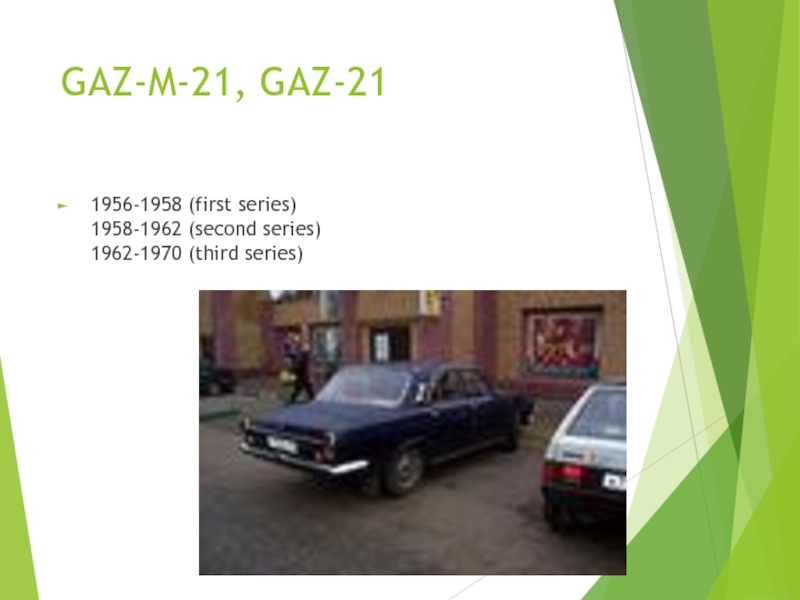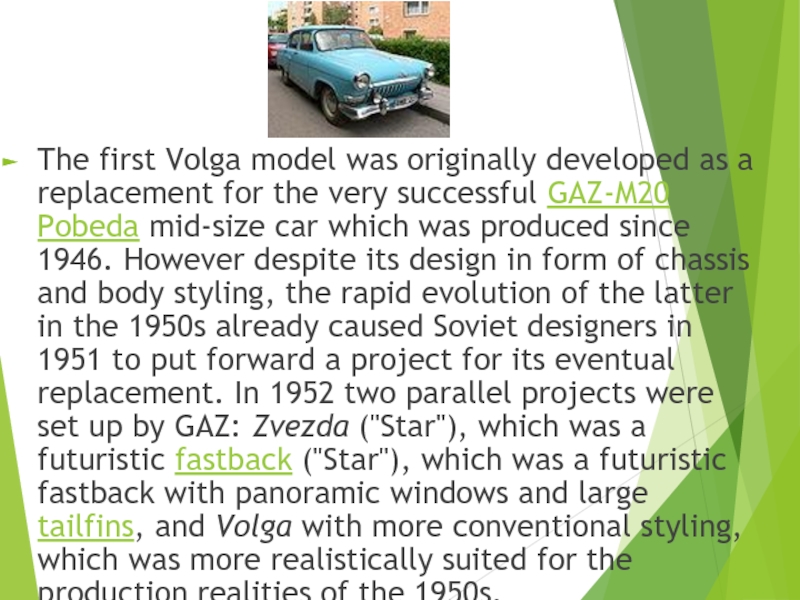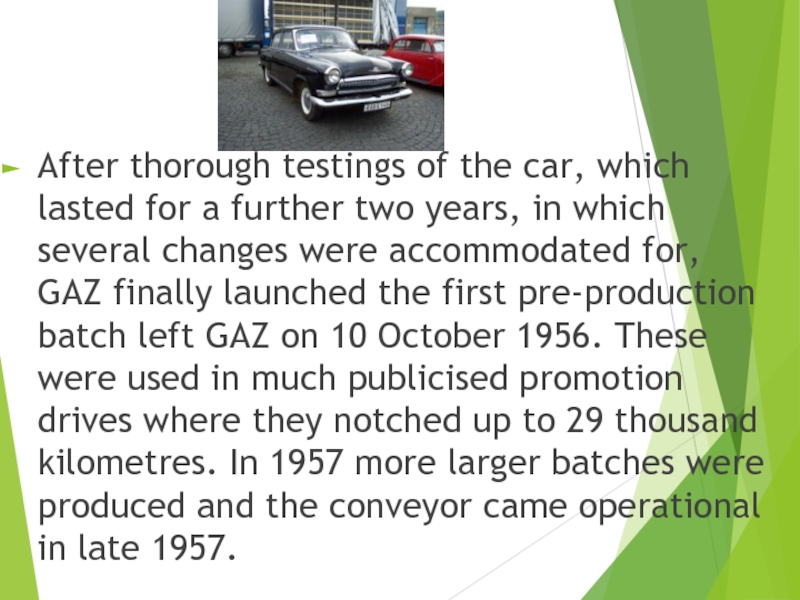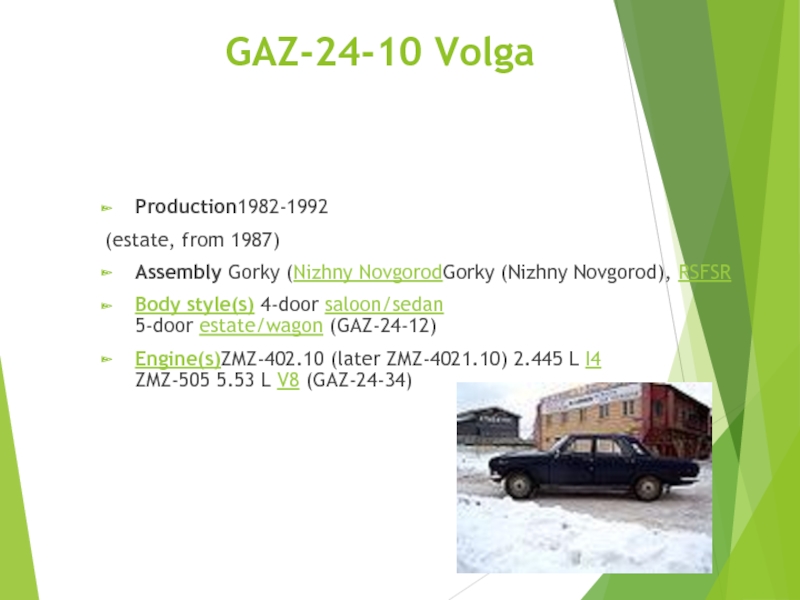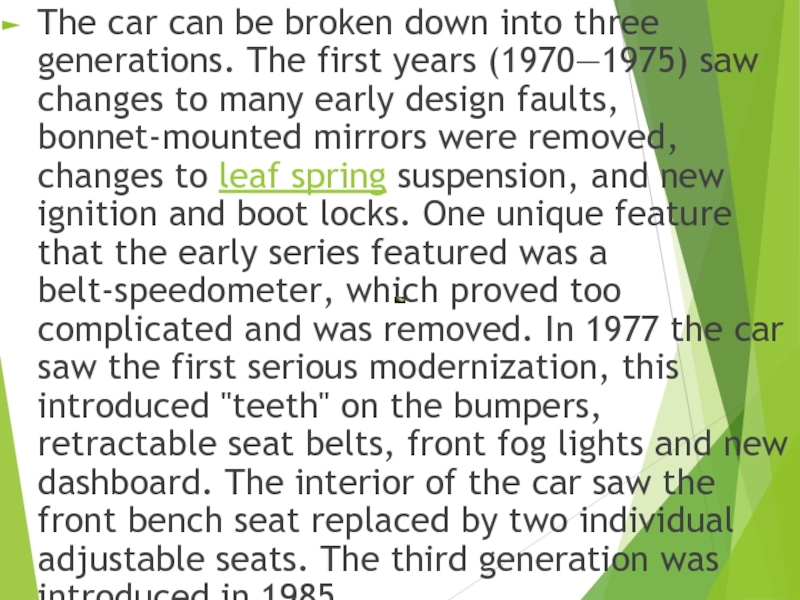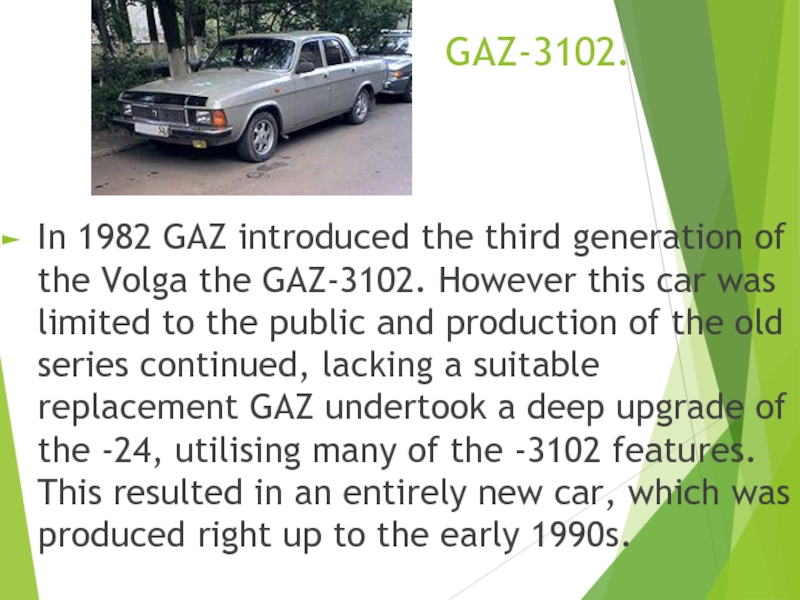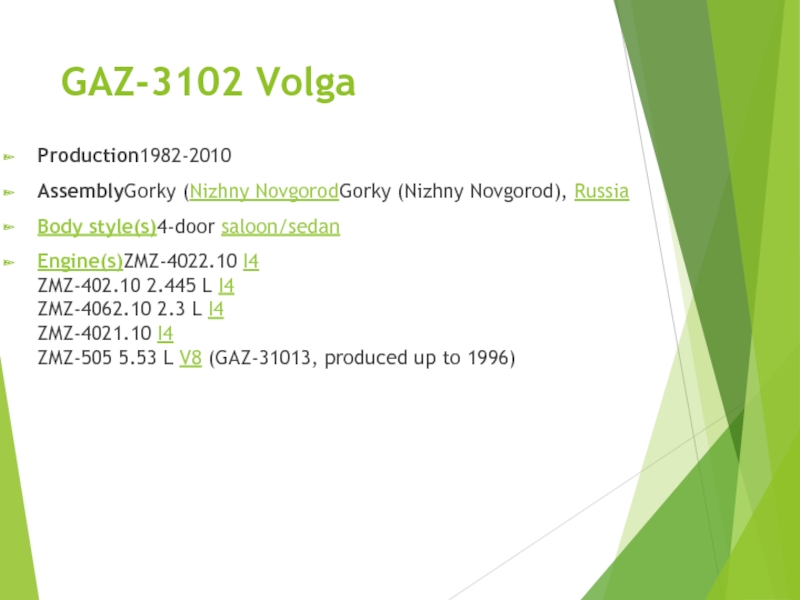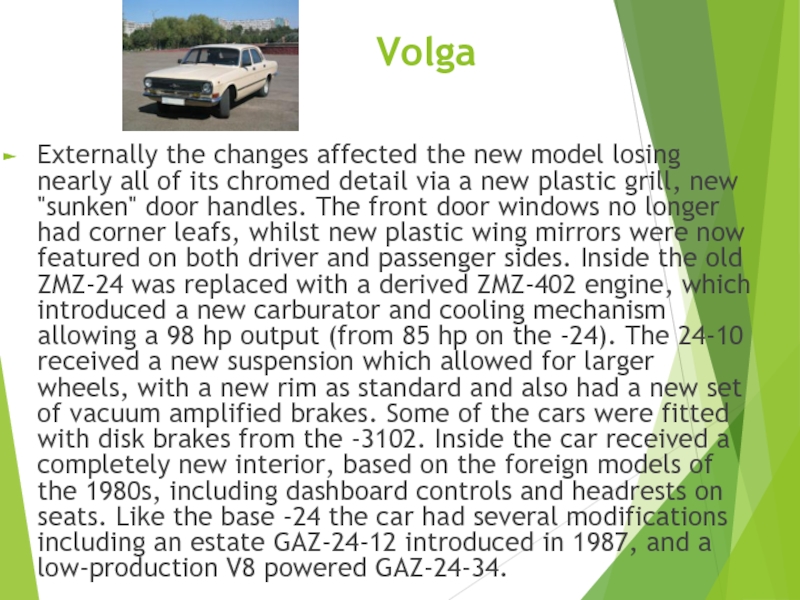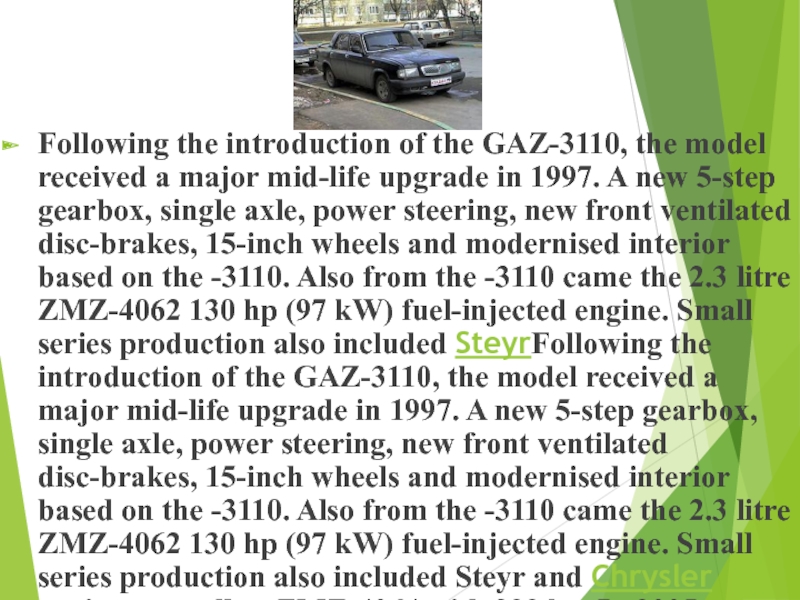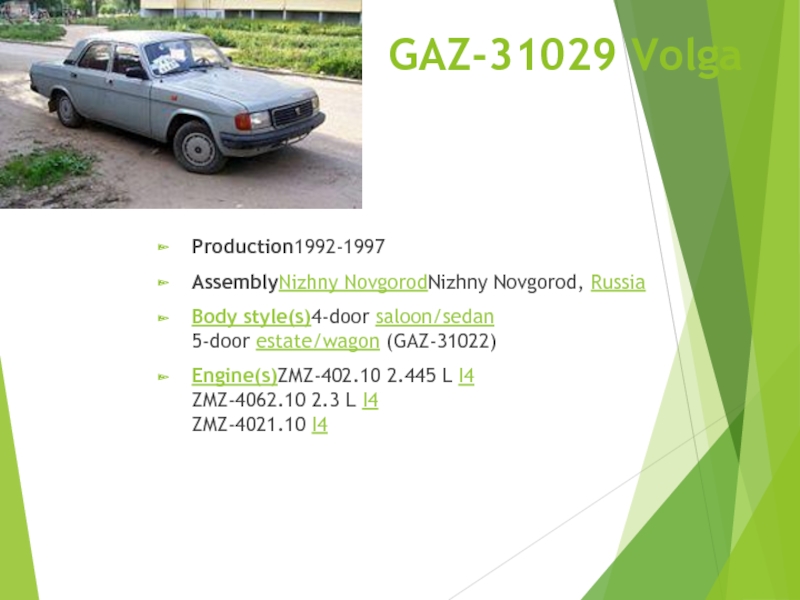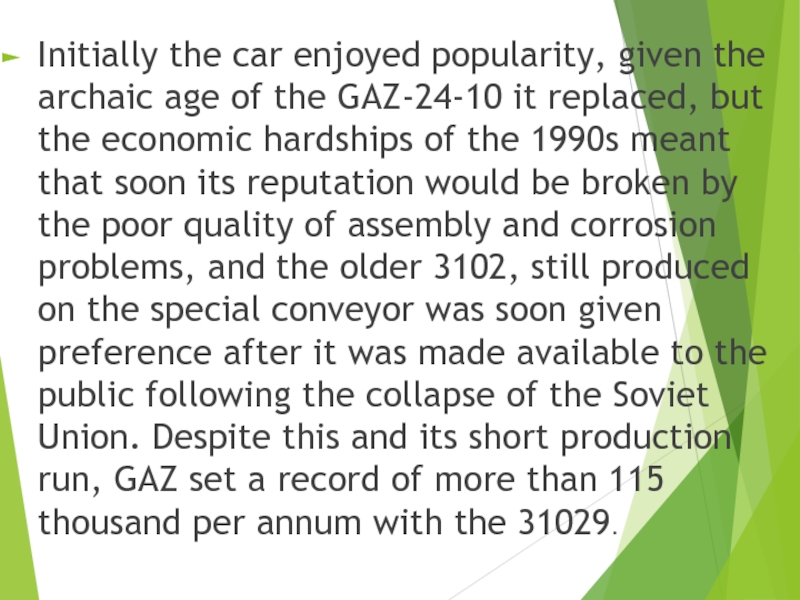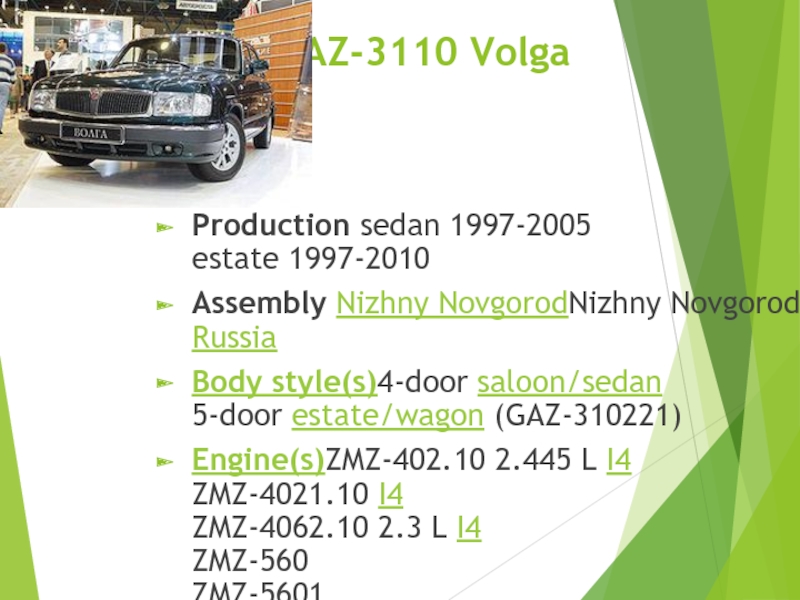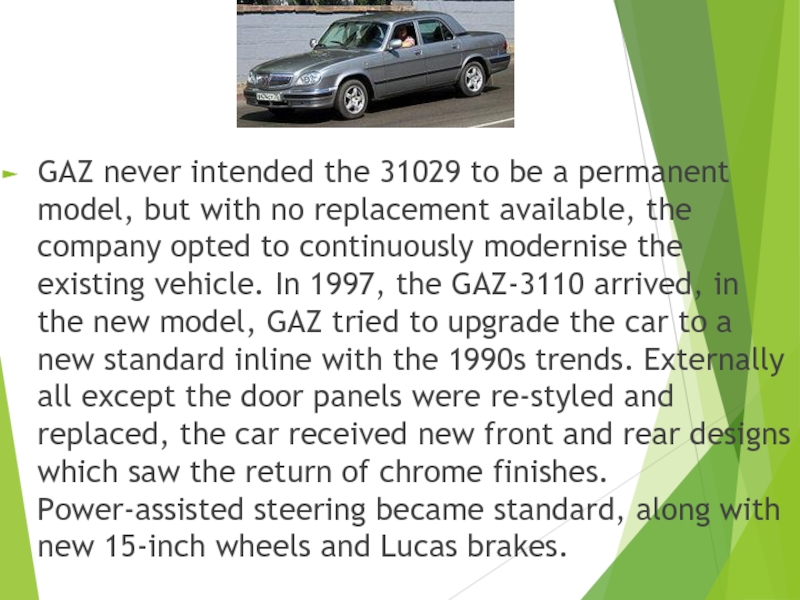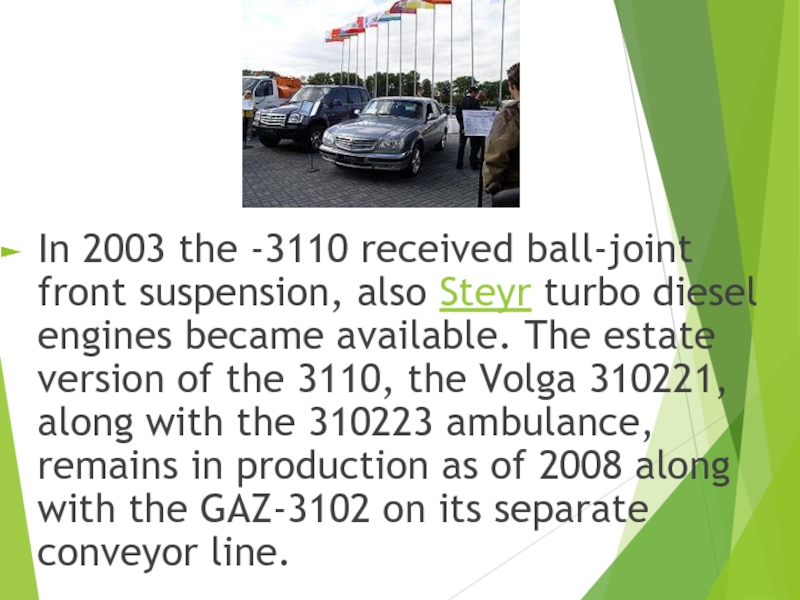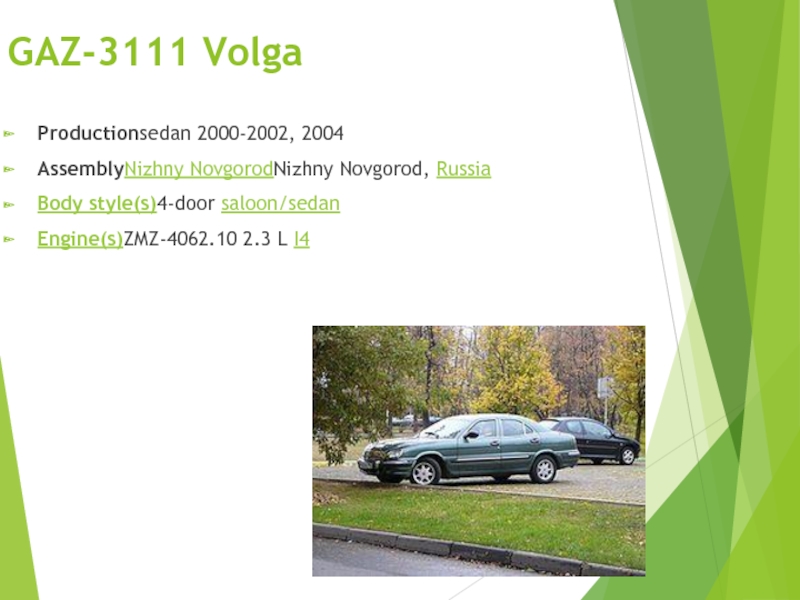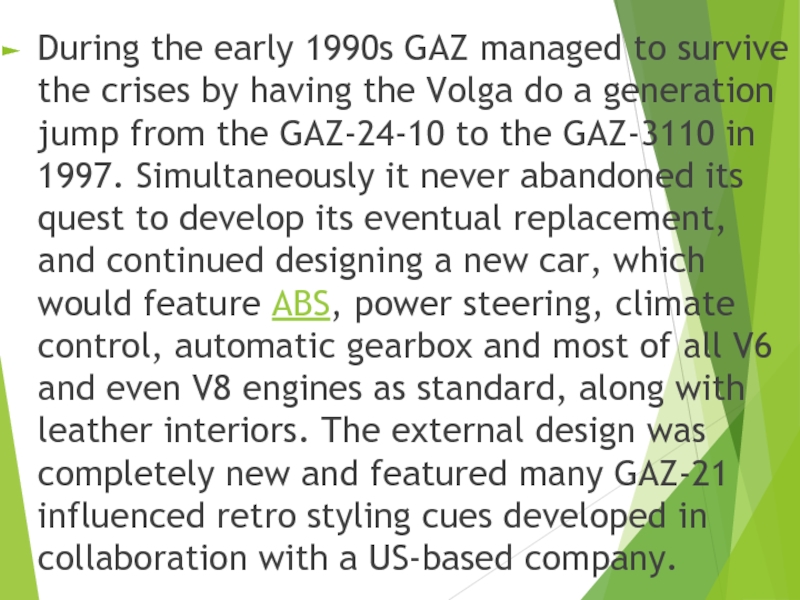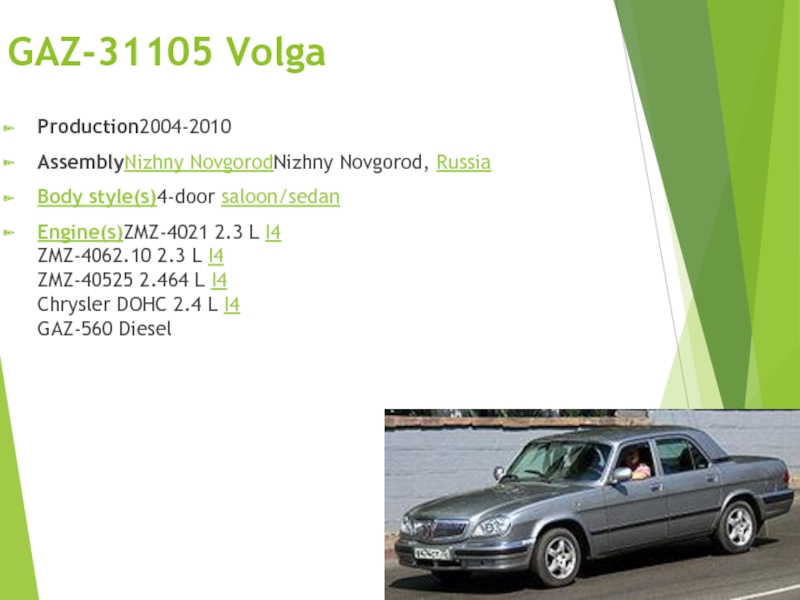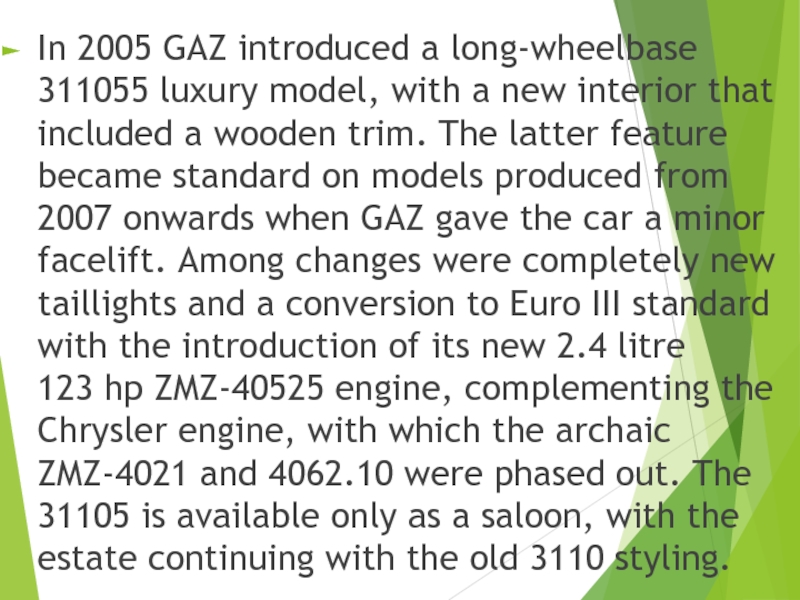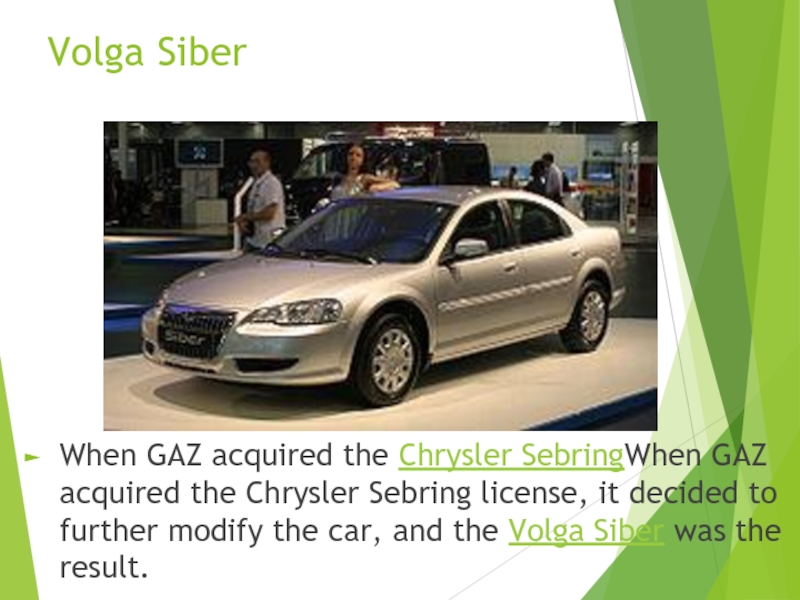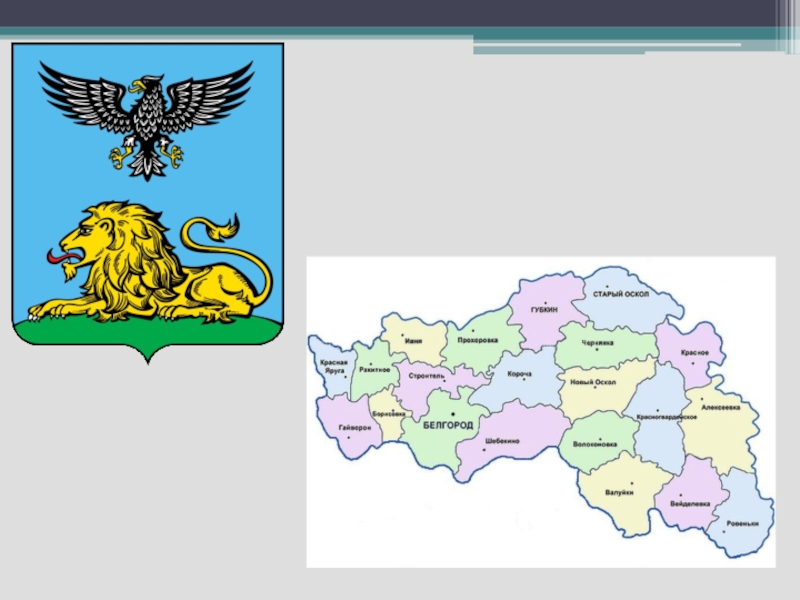Слайд 1GAZ Volga
History of automobile
Слайд 2GAZ Volga
ManufacturerGAZ
Production1956–2010
PredecessorGAZ-M20 Pobeda
Class Mid-size car
Layout Front engine, rear-wheel
drive
Слайд 3GAZ Volga
Volga is an automobile brand that originated in
the Soviet Union is an automobile brand that originated in
the Soviet Union to replace the venerated GAZ-M20 Pobeda is an automobile brand that originated in the Soviet Union to replace the venerated GAZ-M20 Pobeda in 1956. Modern in design, it became a symbol of higher status in the Soviet nomenklatura is an automobile brand that originated in the Soviet Union to replace the venerated GAZ-M20 Pobeda in 1956. Modern in design, it became a symbol of higher status in the Soviet nomenklatura. Volga cars were also traditionally used as taxi cabs, road police interceptors, and ambulances (based on the estate versions).
Four generations of Volga cars have been produced, each undergoing several updates during the production run.
Слайд 4GAZ-M-21, GAZ-21
1956-1958 (first series)
1958-1962 (second series)
1962-1970 (third series)
Слайд 5The first Volga model was originally developed as a replacement
for the very successful GAZ-M20 Pobeda mid-size car which was
produced since 1946. However despite its design in form of chassis and body styling, the rapid evolution of the latter in the 1950s already caused Soviet designers in 1951 to put forward a project for its eventual replacement. In 1952 two parallel projects were set up by GAZ: Zvezda ("Star"), which was a futuristic fastback ("Star"), which was a futuristic fastback with panoramic windows and large tailfins, and Volga with more conventional styling, which was more realistically suited for the production realities of the 1950s.
Слайд 6By the spring of 1954 the Volga prototypes were being
actively tested. The new car introduced a range of additions
and advantages over the Pobeda; in addition to being bigger, it had single panoramic forward and rear windscreens, a larger four-cylinder overhead-valve engine, central lubrication of the main chassis elements, hypoidal rear axle and automatic hydromechanical gearbox.
The car's external design was made by Lev Yeremeev and largely influenced by Western vehicles of the same period, American in particular. Internal design, however, was mostly independent, with an exception for the automatic transmission that was developed from the 3-speed Ford-O-Matic.
Слайд 7After thorough testings of the car, which lasted for a
further two years, in which several changes were accommodated for,
GAZ finally launched the first pre-production batch left GAZ on 10 October 1956. These were used in much publicised promotion drives where they notched up to 29 thousand kilometres. In 1957 more larger batches were produced and the conveyor came operational in late 1957.
Слайд 8GAZ-24 Volga
Production1968-1977 (first series)
1977-1985 (second series) Assembly Gorky (Nizhny
NovgorodGorky (Nizhny Novgorod), RSFSR
Body style(s)4-door saloon/sedan
5-door estate/wagon
Engine(s)ZMZ-24 (later ZMZ-2401) 2.445 L I4
ZMZ-2424 5.53 L V8 (GAZ-24-24)
Related
Chevrolet NovaChevrolet Nova, Dodge DartChevrolet Nova, Dodge Dart, Plymouth Valiant
Слайд 9GAZ-24-10 Volga
Production1982-1992
(estate, from 1987)
Assembly Gorky (Nizhny NovgorodGorky (Nizhny
Novgorod), RSFSR
Body style(s) 4-door saloon/sedan
5-door estate/wagon (GAZ-24-12)
Engine(s)ZMZ-402.10 (later ZMZ-4021.10) 2.445 L
I4
ZMZ-505 5.53 L V8 (GAZ-24-34)
Слайд 10In 1982 GAZ introduced the third generation of the Volga
the GAZ-3102. However this car was limited to the public
and production of the old series continued, lacking a suitable replacement GAZ undertook a deep upgrade of the -24, utilising many of the -3102 features. This resulted in an entirely new car, which was produced right up to the early 1990s.
Слайд 11Development of the replacement for GAZ-21 began as early as
1961, the new car would have to include a modernised
4-cylinder engine of the old Volga along with a six-cylinder, and an automatic transmission. The latter two plans were canceled and by 1965 GAZ finalised the design with a standard 2.5 litre I4 and a 5.5 litre V8 for the government authorities. In 1966 the first prototypes were demonstrated, and in 1967 the concept carDevelopment of the replacement for GAZ-21 began as early as 1961, the new car would have to include a modernised 4-cylinder engine of the old Volga along with a six-cylinder, and an automatic transmission. The latter two plans were canceled and by 1965 GAZ finalised the design with a standard 2.5 litre I4 and a 5.5 litre V8 for the government authorities. In 1966 the first prototypes were demonstrated, and in 1967 the concept car was demonstrated on foreign and domestic Auto showDevelopment of the replacement for GAZ-21 began as early as 1961, the new car would have to include a modernised 4-cylinder engine of the old Volga along with a six-cylinder, and an automatic transmission. The latter two plans were canceled and by 1965 GAZ finalised the design with a standard 2.5 litre I4 and a 5.5 litre V8 for the government authorities. In 1966 the first prototypes were demonstrated, and in 1967 the concept car was demonstrated on foreign and domestic Auto show. The first batch of 24 vehicles were assembled in 1968, 215 more followed in 1969 and the main conveyor in Gorky was launched in 1970.
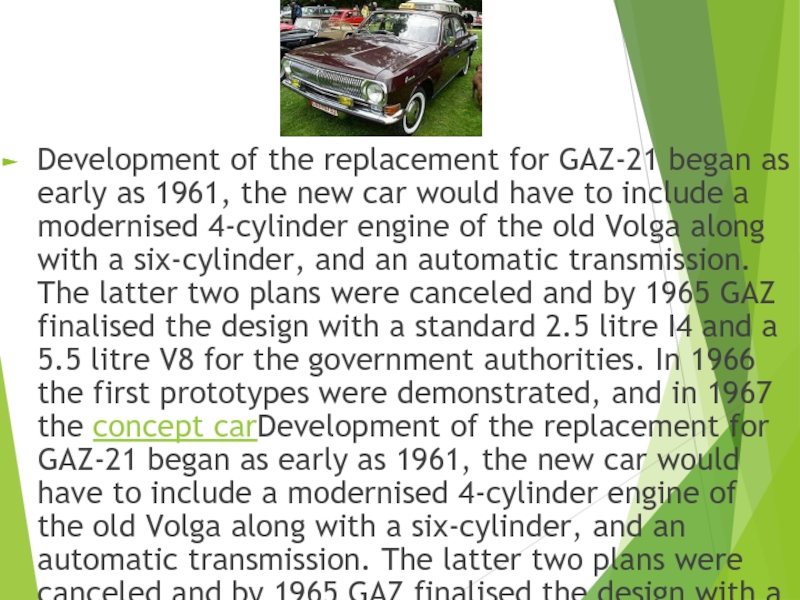
Слайд 12The car can be broken down into three generations. The
first years (1970—1975) saw changes to many early design faults,
bonnet-mounted mirrors were removed, changes to leaf spring suspension, and new ignition and boot locks. One unique feature that the early series featured was a belt-speedometer, which proved too complicated and was removed. In 1977 the car saw the first serious modernization, this introduced "teeth" on the bumpers, retractable seat belts, front fog lights and new dashboard. The interior of the car saw the front bench seat replaced by two individual adjustable seats. The third generation was introduced in 1985
Слайд 13GAZ-3102.
In 1982 GAZ introduced the third generation of the Volga
the GAZ-3102. However this car was limited to the public
and production of the old series continued, lacking a suitable replacement GAZ undertook a deep upgrade of the -24, utilising many of the -3102 features. This resulted in an entirely new car, which was produced right up to the early 1990s.
Слайд 14The most serious modification however was the GAZ-24-24 which was
powered by a 5.53 litre, 195 hp V8 engine borrowed from
GAZ-13 ChaikaThe most serious modification however was the GAZ-24-24 which was powered by a 5.53 litre, 195 hp V8 engine borrowed from GAZ-13 Chaika. On top of that it featured a three-gear automatic gearbox, power-assisted steering and reinforced chassis and suspension. This car was never available for private ownership and was used by the KGB services. (This fact may have contributed to the development of the urban legendThe most serious modification however was the GAZ-24-24 which was powered by a 5.53 litre, 195 hp V8 engine borrowed from GAZ-13 Chaika. On top of that it featured a three-gear automatic gearbox, power-assisted steering and reinforced chassis and suspension. This car was never available for private ownership and was used by the KGB services. (This fact may have contributed to the development of the urban legend of the Black volgaThe most serious modification however was the GAZ-24-24 which was powered by a 5.53 litre, 195 hp V8 engine borrowed from GAZ-13 Chaika. On top of that it featured a three-gear automatic gearbox, power-assisted steering and reinforced chassis and suspension. This car was never available for private ownership and was used by the KGB services. (This fact may have contributed to the development of the urban legend of the Black volga that was popular in the Poland in the 1970s.)
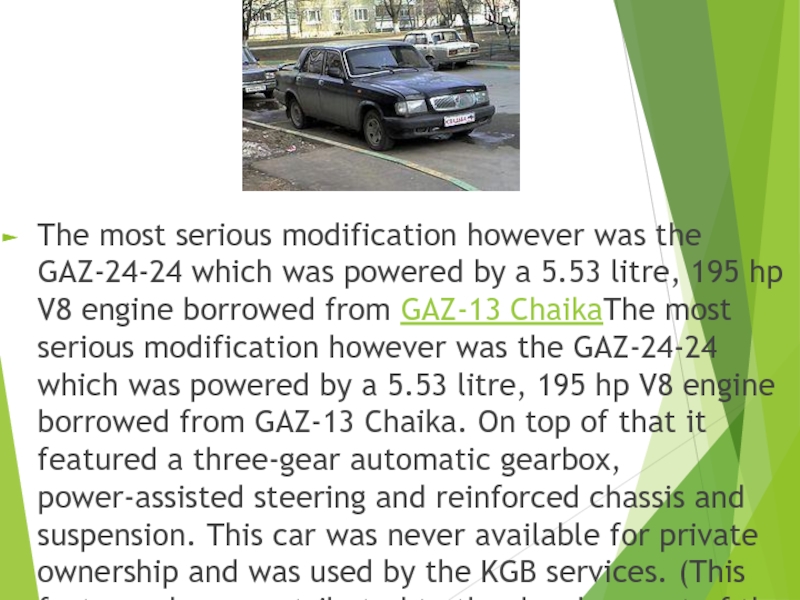
Слайд 15GAZ-3102 Volga
Production1982-2010
AssemblyGorky (Nizhny NovgorodGorky (Nizhny Novgorod), Russia
Body style(s)4-door saloon/sedan
Engine(s)ZMZ-4022.10
I4
ZMZ-402.10 2.445 L I4
ZMZ-4062.10 2.3 L I4
ZMZ-4021.10 I4
ZMZ-505 5.53 L V8 (GAZ-31013, produced
up to 1996)
Слайд 16In late 1976, a review of the GAZ-24 was tasked
with finding out the main drawbacks that would need to
be fixed in its replacement, the design of which was scheduled to begin. However funds were never allocated for the project. Simultaneously GAZ launched the second generation of the ChaikaIn late 1976, a review of the GAZ-24 was tasked with finding out the main drawbacks that would need to be fixed in its replacement, the design of which was scheduled to begin. However funds were never allocated for the project. Simultaneously GAZ launched the second generation of the Chaika limousine. The GAZ-14 in its size and interior jumped the class from its predecessor. Thus instead of replacing the Volga, GAZ was tasked with creating a new vehicle that would be suitable for the mid-class of the Soviet nomenklaturaIn late 1976, a review of the GAZ-24 was tasked with finding out the main drawbacks that would need to be fixed in its replacement, the design of which was scheduled to begin. However funds were never allocated for the project. Simultaneously GAZ launched the second generation of the Chaika limousine. The GAZ-14 in its size and interior jumped the class from its predecessor. Thus instead of replacing the Volga, GAZ was tasked with creating a new vehicle that would be suitable for the mid-class of the Soviet nomenklatura. Loosely based on its predecessor, the new Volga, in addition to receiving a new model number, had much of the Chaika's innovations incorporated in the design.
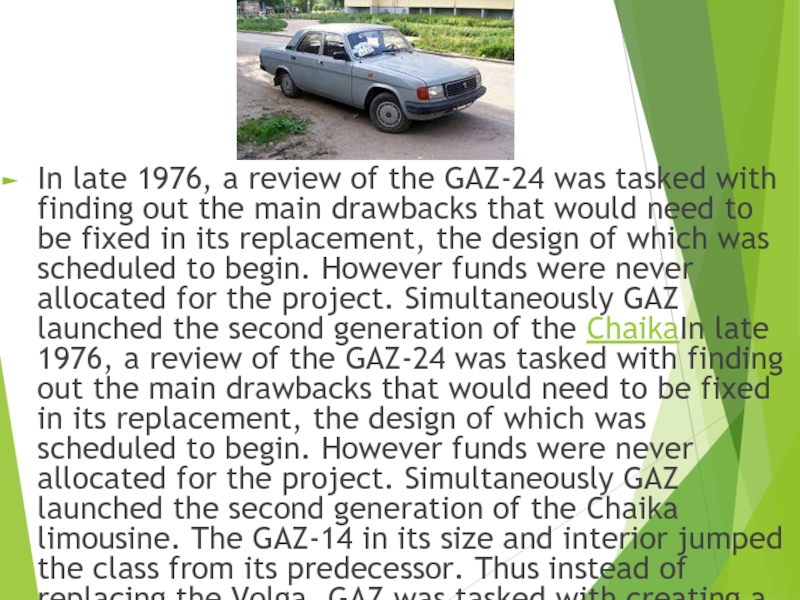
Слайд 17Volga
Externally the changes affected the new model losing nearly
all of its chromed detail via a new plastic grill,
new "sunken" door handles. The front door windows no longer had corner leafs, whilst new plastic wing mirrors were now featured on both driver and passenger sides. Inside the old ZMZ-24 was replaced with a derived ZMZ-402 engine, which introduced a new carburator and cooling mechanism allowing a 98 hp output (from 85 hp on the -24). The 24-10 received a new suspension which allowed for larger wheels, with a new rim as standard and also had a new set of vacuum amplified brakes. Some of the cars were fitted with disk brakes from the -3102. Inside the car received a completely new interior, based on the foreign models of the 1980s, including dashboard controls and headrests on seats. Like the base -24 the car had several modifications including an estate GAZ-24-12 introduced in 1987, and a low-production V8 powered GAZ-24-34.
Слайд 18Following the introduction of the GAZ-3110, the model received a
major mid-life upgrade in 1997. A new 5-step gearbox, single
axle, power steering, new front ventilated disc-brakes, 15-inch wheels and modernised interior based on the -3110. Also from the -3110 came the 2.3 litre ZMZ-4062 130 hp (97 kW) fuel-injected engine. Small series production also included SteyrFollowing the introduction of the GAZ-3110, the model received a major mid-life upgrade in 1997. A new 5-step gearbox, single axle, power steering, new front ventilated disc-brakes, 15-inch wheels and modernised interior based on the -3110. Also from the -3110 came the 2.3 litre ZMZ-4062 130 hp (97 kW) fuel-injected engine. Small series production also included Steyr and Chrysler engines as well as ZMZ-4064 with 200 hp. In 2005, following the introduction of the GAZ-31105, the -3102 incorporates its interior, and in 2008 its engine standard becomes the 2.5 litre ZMZ-205 which answers to EuroIII standards.
Слайд 19GAZ-31029 Volga
Production1992-1997
AssemblyNizhny NovgorodNizhny Novgorod, Russia
Body style(s)4-door saloon/sedan
5-door estate/wagon (GAZ-31022)
Engine(s)ZMZ-402.10
2.445 L I4
ZMZ-4062.10 2.3 L I4
ZMZ-4021.10 I4
Слайд 20Initially the car enjoyed popularity, given the archaic age of
the GAZ-24-10 it replaced, but the economic hardships of the
1990s meant that soon its reputation would be broken by the poor quality of assembly and corrosion problems, and the older 3102, still produced on the special conveyor was soon given preference after it was made available to the public following the collapse of the Soviet Union. Despite this and its short production run, GAZ set a record of more than 115 thousand per annum with the 31029.
Слайд 21GAZ-3110 Volga
Production sedan 1997-2005
estate 1997-2010
Assembly Nizhny NovgorodNizhny Novgorod, Russia
Body
style(s)4-door saloon/sedan
5-door estate/wagon (GAZ-310221)
Engine(s)ZMZ-402.10 2.445 L I4
ZMZ-4021.10 I4
ZMZ-4062.10 2.3 L I4
ZMZ-560
ZMZ-5601
Слайд 22GAZ never intended the 31029 to be a permanent model,
but with no replacement available, the company opted to continuously
modernise the existing vehicle. In 1997, the GAZ-3110 arrived, in the new model, GAZ tried to upgrade the car to a new standard inline with the 1990s trends. Externally all except the door panels were re-styled and replaced, the car received new front and rear designs which saw the return of chrome finishes. Power-assisted steering became standard, along with new 15-inch wheels and Lucas brakes.
Слайд 23In 2003 the -3110 received ball-joint front suspension, also Steyr
turbo diesel engines became available. The estate version of the
3110, the Volga 310221, along with the 310223 ambulance, remains in production as of 2008 along with the GAZ-3102 on its separate conveyor line.
Слайд 24GAZ-3111 Volga
Productionsedan 2000-2002, 2004
AssemblyNizhny NovgorodNizhny Novgorod, Russia
Body style(s)4-door saloon/sedan
Engine(s)ZMZ-4062.10
2.3 L I4
Слайд 25During the early 1990s GAZ managed to survive the crises
by having the Volga do a generation jump from the
GAZ-24-10 to the GAZ-3110 in 1997. Simultaneously it never abandoned its quest to develop its eventual replacement, and continued designing a new car, which would feature ABS, power steering, climate control, automatic gearbox and most of all V6 and even V8 engines as standard, along with leather interiors. The external design was completely new and featured many GAZ-21 influenced retro styling cues developed in collaboration with a US-based company.
Слайд 26GAZ-31105 Volga
Production2004-2010
AssemblyNizhny NovgorodNizhny Novgorod, Russia
Body style(s)4-door saloon/sedan
Engine(s)ZMZ-4021 2.3 L I4
ZMZ-4062.10
2.3 L I4
ZMZ-40525 2.464 L I4
Chrysler DOHC 2.4 L I4
GAZ-560 Diesel
Слайд 27In 2005 GAZ introduced a long-wheelbase 311055 luxury model, with
a new interior that included a wooden trim. The latter
feature became standard on models produced from 2007 onwards when GAZ gave the car a minor facelift. Among changes were completely new taillights and a conversion to Euro III standard with the introduction of its new 2.4 litre 123 hp ZMZ-40525 engine, complementing the Chrysler engine, with which the archaic ZMZ-4021 and 4062.10 were phased out. The 31105 is available only as a saloon, with the estate continuing with the old 3110 styling.
Слайд 28Volga Siber
When GAZ acquired the Chrysler SebringWhen GAZ acquired
the Chrysler Sebring license, it decided to further modify the
car, and the Volga Siber was the result.


